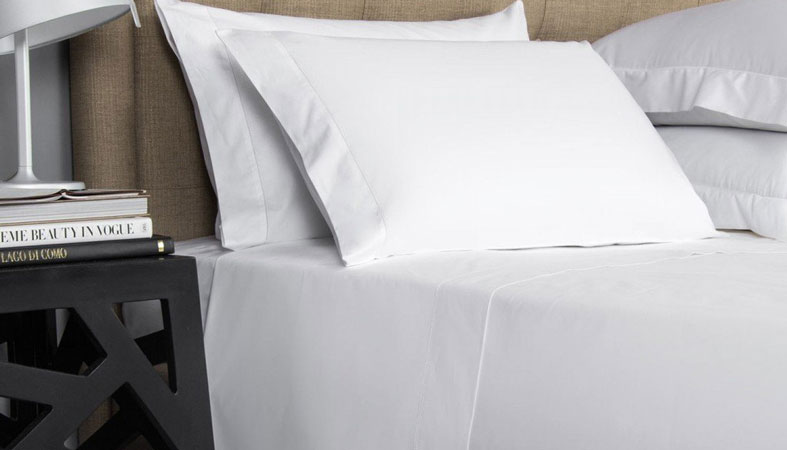Your sheets are an important part of furnishing your bed for a good night’s sleep. When you shop for sheets, though, you can become inundated with all sorts of fabric choices, and two of the more popular options include bamboo and cotton. That raises the question, should you get sheets made of bamboo or cotton?
While they share similarities, they also have distinct differences that are worth your consideration. With this said, let’s have a look at the differences between them and which material would be best for you.

What Are Bamboo Sheets?
Bamboo sheets are made out of bamboo fiber. The latter is made out of a characteristic bamboo species, which is more or less like timber. The manufacturing process altogether is quite different, depending on the goals and the particular fabric production.
There are three distinct types of fabric currently on the market, and the main difference stems from the overall process of manufacturing the fibers.
Want to know more? Read our complete guide for the best bamboo sheets here.
Types of Bamboo Fiber
Rayon/Viscose
Most of these sheets are made of bamboo rayon. This is generally the first generation when it comes to cellulosic fibers. There are different processes used for their manufacturing, and they all differ regarding their overall environmental impact.
The chemical residue remains in the disposal of the waste product, and while this might not be the best environmental approach, it does make the sheet free of chemicals.
For More Info:
Tencel Bamboo (Lyocell)
Bamboo Lyocell is one of the most contemporary and sustainable textile materials. No chemical residue makes its way into the environment because the components are non-toxic and non-hazardous.
Bamboo Linen
The manufacturing process used to produce this linen is used to make regular linen as well. Bamboo linen is a sustainable fabric known for being prone to wrinkles, and it’s not very soft. However, it’s more cooling.
Pros and Cons of Bamboo Sheets
Pros:
- Can be more eco-friendly – According to research1, bamboo fiber is both eco-friendly and biodegradable.
- Soft and comfortable – Bamboo fibers can feel cozy and soft, which can be a treat when it’s time to get into bed.
- Hypoallergenic – Bamboo sheets can be hypoallergenic, so they’re a good choice if you typically struggle with allergies.
- Breathable – If you often get hot when sleeping, bamboo fiber is more breathable and moisture-absorbing.1
- Durable – Bamboo fibers are very durable, which means they can last you a long time without tearing or pilling.
- Antibacterial and odor-reducing – Another benefit of bamboo fiber is that it’s antibacterial and deodorizing.1 This means it can help prevent bacterial growth (think mold and mildew) and undesirable smells.
Cons:
- May be more prone to staining – We mentioned that this material is moisture-absorbing, but this can also mean it can stain more easily if an accident happens.
- Expensive – Bamboo sheets may cost more than other materials available, more so if they’re made from pure bamboo and without any other fabrics.
- Potential presence of chemicals – Although cultivating bamboo is more eco-friendly, processing the material might not be, which may involve chemical use. Therefore, it’s worth doing some research into a specific brand and their manufacturing process if you have any concerns about this.
What Are Cotton Sheets?
Cotton is a broadly used material for making sheets. The thread count of cotton is lower and can be scratchy, and it is more likely to pill.
However, there are more premium variations made with finer threads and higher thread counts, which can result in a more luxurious, softer product.
Read Our Full Guide: Top Rated Cotton Sheets

Types of Cotton
Egyptian
100 percent Egyptian cotton is considered the top cotton variation. Egyptian cotton sheets are very soft and sleep cool. However, these sheets tend to cost more because they are so luxurious.
Pima
Pima sheets are the second-best type of cotton. They are also soft but are a bit rougher compared to Egyptian ones. Like Egyptian sheets, Pima cotton will also run more expensive.
Different Cotton Weaves
Percale
Percale is a plain-weave fabric conveniently made of combed and carded cotton yards. The weave is closely woven and produces a crisp, smooth finish.
Sateen
Sateen is a type of weave that takes advantage of more vertical threads as opposed to horizontal ones, and it produces a very soft feel.
Flannel
Flannel is often ideal for winter to help with keeping warm. Sheets made with this weave typically have a napped finish on both sides.
Jersey
Jersey is a type of knit that can create a soft feel. Jersey cotton can resemble that of a T-shirt, which means it’s easy to work with and lightweight enough not to overheat you.
Pros and Cons of Cotton Sheets
Pros:
- Affordable – Cotton sheets are affordable, but this can also depend on the type of cotton you get. For example, more high-end makes, such as Egyptian cotton, would likely cost you more.
- Easy to clean – Cotton is incredibly easy to clean since you can hand-wash or machine-wash it, depending on your preference.
- They become softer – Your cotton sheets are likely to become even softer over time due to the nature of the fabric.
- Breathable – Much like bamboo, cotton is breathable. As such, it’s a good option for hot sleepers and those who sweat at night.
Cons:
- Prone to shrinking – Cotton tends to shrink when you wash it, which can be a problem if you have fitted sheets. For this reason, make sure to follow the manufacturer’s instructions for washing.
- Not eco-friendly – The fibers themselves might be eco-friendly, but the harvesting process is questionable since cotton requires more water to produce it.
- They get wrinkly – Cotton might not be as easy to iron as bamboo, which is bad news given that it tends to get wrinkly. However, some weaves, such as sateen, are not as prone to wrinkling.
Bamboo vs. Cotton Sheets
Thread Count
Thread count tells us a lot more about the quality of the bed linen, and it does so more for cotton than bamboo. Generally, the higher the thread count is, the softer they are going to feel.
The fibers in bamboo materials are usually considered to be softer than those in cotton.1 That said, there are still many high-end cotton materials with a high threat count that are very soft. Nevertheless, the wide majority of bamboo bed linen will be far softer compared to regular cotton.
Comfort
When it comes to comfort, the topic gets more subjective. Cotton sheets are broad, and there are a lot of different specifications to account for. They could deliver a cheap and not-so-pleasant feel if you opt for a low thread count, but they could also be very soft and appealing if you get a luxurious set.
At the same time, bamboo delivers an expressively sustained level of comfort. They are usually very soft, and they feel great for the most part.
Care and Durability
Each set of bed linens that you buy will have specific care instructions. We always recommend you follow the manufacturer’s guidelines for cleaning your sheets to ensure they remain in mint condition.
Regarding durability, bamboo fabric tends to be more durable than cotton because it’s less prone to tearing or pilling. However, proper cleaning maintenance will impact this, so to ensure long-term use, follow those company directions.
Learn More: How Often Should You Wash Your Bed Sheets?
Environmentally Friendly
Bambo fiber is considered eco-friendly and biodegradable.1 Cotton, on the other hand, requires more water in its manufacturing process, limiting its eco-friendly impact. Ultimately, though, if a product’s environmental status is a priority for you as a customer, it’s best to research the company, including both the materials used and the production process.
Coolness Factor
Both cotton and bamboo are breathable, but between the two, you’ll likely find better cooling with bamboo sheets.
Another consideration here is thread count; high-thread cotton sheets also tend to be very breathable, but they can come with a heftier price tag. Meanwhile, bamboo sheets are naturally breathable, and their coolness doesn’t impact the price.
Interested in learning more? See our complete guide for cooling sheets.
Cost
Bamboo sheets, in general, tend to be more expensive compared to low-quality cotton, but if you match the thread count, the price would more or less equalize. Of course, there are different types from both categories, which would cost a lot more compared to the regular, entry-level options.
Frequently Asked Questions
How do you choose the right sheets?
The right sheets will depend on what qualities are most important to you. Are most concerned with how cool they sleep? Is their environmental impact a big deal? What’s your budget? Ideally, you want to get whatever sheets best meet your needs and preferences.
Is bamboo cooler than cotton?
Both cotton and bamboo are breathable and suitable for hot sleepers. However, bamboo is typically more temperature-regulating than cotton. While cotton with a high thread count can sleep cooler, you might have to pay more. In this case, you might get more bang for your buck with a bamboo sheet set.
Which type of sheets is softer?
Generally, bamboo is softer than cotton1. However, the weave of the cotton can impact softness. For example, Egyptian and Pima cotton can be exceptionally soft and luxurious.
Also, cotton tends to soften after a while, so you can expect your sheets to feel softer after several washes.
Is bamboo better than cotton?
We wouldn’t go as far as to say any material is better than the other. Both bamboo and cotton have their pros and cons, so it’s a matter of picking what’s worth your money and would help you sleep better.
Conclusion
Between the two, bamboo appears to slightly out-edge cotton. However, the decision will ultimately come down to you and what you like best. For example, if you prefer something with a better environmental impact, you might prefer bamboo. On the other hand, if you want something more affordable but still breathable, a standard cotton set could be best.

Olivera Jancikin
Content Writer
About Author
Olivera is a content writer for Sleep Advisor and is enthusiastic about sleep. She firmly believes in the benefits of daytime naps on top of getting a full 8-hour sleep at night.
Combination Sleeper
References:
- “Bamboo Fiber”. Science Direct. Webpage accessed April 4, 2024.
